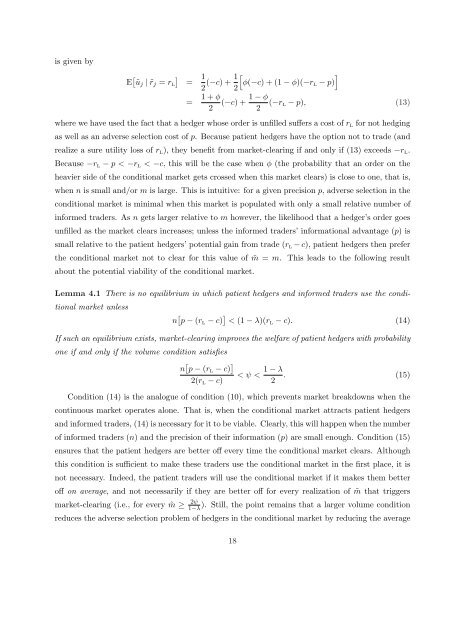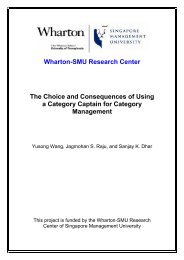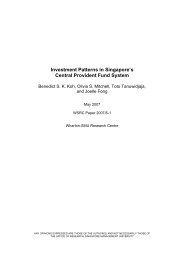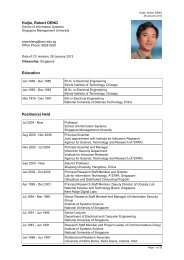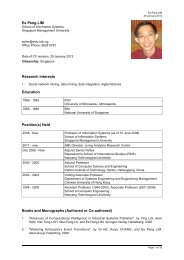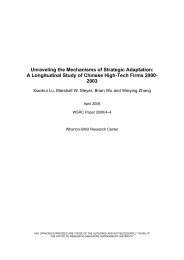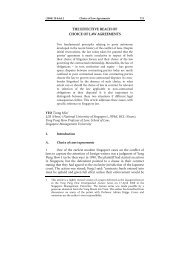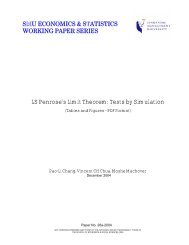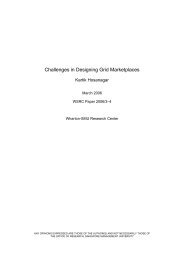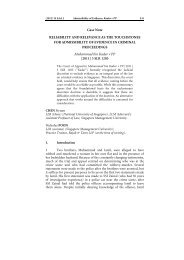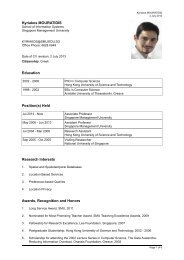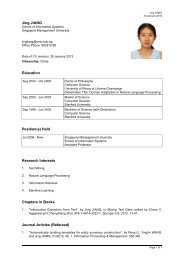The Benefits of Volume-Conditional Order-Crossing - Singapore ...
The Benefits of Volume-Conditional Order-Crossing - Singapore ...
The Benefits of Volume-Conditional Order-Crossing - Singapore ...
Create successful ePaper yourself
Turn your PDF publications into a flip-book with our unique Google optimized e-Paper software.
is given by<br />
E <br />
ũj | ˜rj = rL =<br />
1 1<br />
<br />
<br />
(−c) + φ(−c) + (1 − φ)(−rL − p)<br />
2 2<br />
= 1 + φ 1 − φ<br />
(−c) + (−rL − p),<br />
2<br />
2<br />
(13)<br />
where we have used the fact that a hedger whose order is unfilled suffers a cost <strong>of</strong> r L for not hedging<br />
as well as an adverse selection cost <strong>of</strong> p. Because patient hedgers have the option not to trade (and<br />
realize a sure utility loss <strong>of</strong> r L), they benefit from market-clearing if and only if (13) exceeds −r L.<br />
Because −r L − p < −r L < −c, this will be the case when φ (the probability that an order on the<br />
heavier side <strong>of</strong> the conditional market gets crossed when this market clears) is close to one, that is,<br />
when n is small and/or m is large. This is intuitive: for a given precision p, adverse selection in the<br />
conditional market is minimal when this market is populated with only a small relative number <strong>of</strong><br />
informed traders. As n gets larger relative to m however, the likelihood that a hedger’s order goes<br />
unfilled as the market clears increases; unless the informed traders’ informational advantage (p) is<br />
small relative to the patient hedgers’ potential gain from trade (r L − c), patient hedgers then prefer<br />
the conditional market not to clear for this value <strong>of</strong> ˜m = m. This leads to the following result<br />
about the potential viability <strong>of</strong> the conditional market.<br />
Lemma 4.1 <strong>The</strong>re is no equilibrium in which patient hedgers and informed traders use the condi-<br />
tional market unless<br />
n p − (r L − c) < (1 − λ)(r L − c). (14)<br />
If such an equilibrium exists, market-clearing improves the welfare <strong>of</strong> patient hedgers with probability<br />
one if and only if the volume condition satisfies<br />
n p − (r L − c) <br />
2(r L − c)<br />
< ψ <<br />
1 − λ<br />
. (15)<br />
2<br />
Condition (14) is the analogue <strong>of</strong> condition (10), which prevents market breakdowns when the<br />
continuous market operates alone. That is, when the conditional market attracts patient hedgers<br />
and informed traders, (14) is necessary for it to be viable. Clearly, this will happen when the number<br />
<strong>of</strong> informed traders (n) and the precision <strong>of</strong> their information (p) are small enough. Condition (15)<br />
ensures that the patient hedgers are better <strong>of</strong>f every time the conditional market clears. Although<br />
this condition is sufficient to make these traders use the conditional market in the first place, it is<br />
not necessary. Indeed, the patient traders will use the conditional market if it makes them better<br />
<strong>of</strong>f on average, and not necessarily if they are better <strong>of</strong>f for every realization <strong>of</strong> ˜m that triggers<br />
market-clearing (i.e., for every ˜m ≥ 2ψ<br />
1−λ ). Still, the point remains that a larger volume condition<br />
reduces the adverse selection problem <strong>of</strong> hedgers in the conditional market by reducing the average<br />
18


